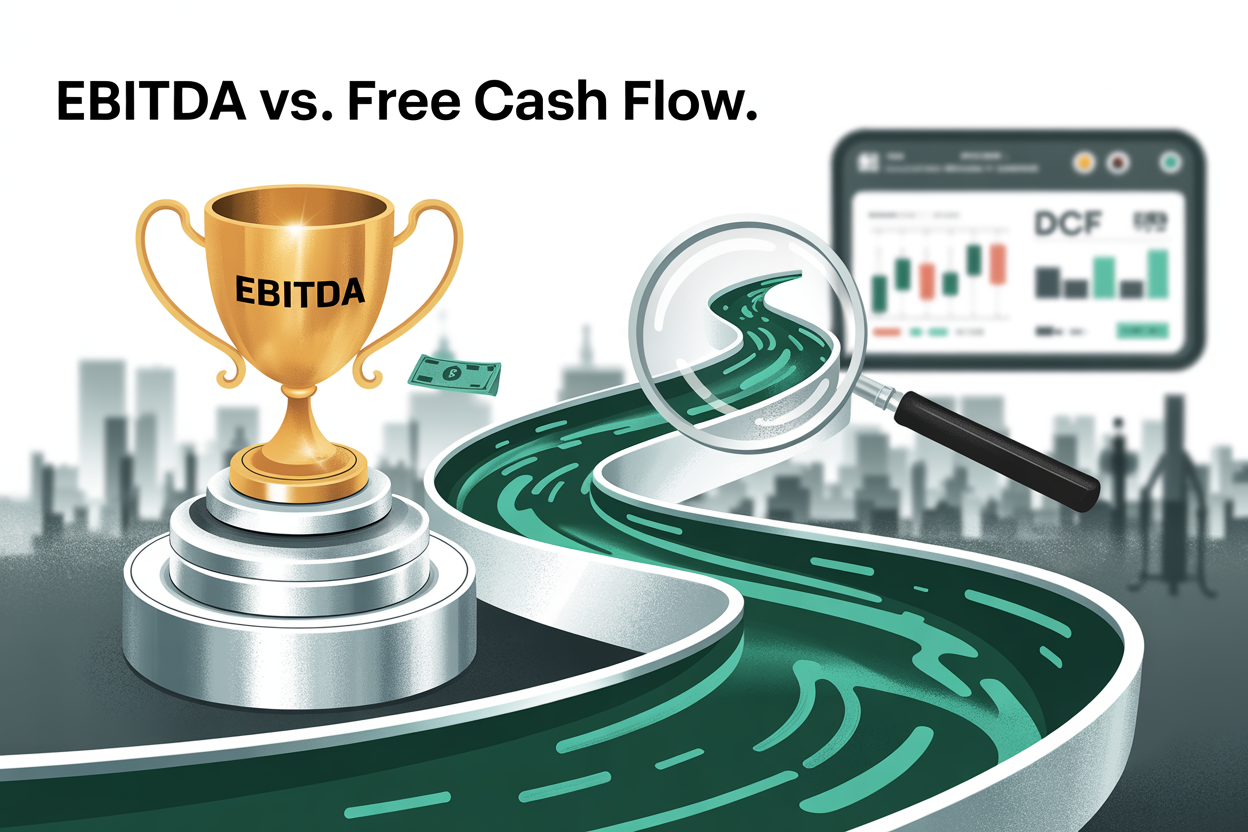Two metrics often dominate the conversation: EBITDA (Earnings Before Interest, Taxes, Depreciation, and Amortization) and Free Cash Flow (FCF). While both provide valuable insights, they serve distinct purposes and can lead to vastly different conclusions about a company’s performance and value. In this article, we’ll unpack the differences between EBITDA and Free Cash Flow, explore their applications, and compare valuation methods, with a particular focus on the Discounted Cash Flow (DCF) approach, to help you make informed strategic decisions.
Understanding EBITDA: A Proxy for Profitability
EBITDA is a widely used metric that strips out non-operating and non-cash expenses to provide a clearer view of a company’s core operational performance. By excluding interest, taxes, depreciation, and amortization, EBITDA offers a standardized way to compare profitability across companies, industries, or geographies, regardless of capital structure or tax regimes.Why EBITDA Matters
- Comparability: EBITDA neutralizes differences in financing (interest), tax policies, and non-cash accounting adjustments (depreciation and amortization), making it ideal for benchmarking peers.
- Valuation Tool: It’s a cornerstone of valuation multiples, such as EV/EBITDA, commonly used in mergers and acquisitions (M&A) to assess a company’s enterprise value.
- Simplicity: EBITDA is easy to calculate from financial statements and provides a quick snapshot of operational efficiency.
Limitations of EBITDA
However, EBITDA has significant shortcomings:
- Non-GAAP/IFRS Metric: It’s not a standardized measure under Generally Accepted Accounting Principles (GAAP) or International Financial Reporting Standards (IFRS), which can lead to inconsistencies in calculation.
- Ignores Cash Realities: EBITDA doesn’t account for working capital changes, capital expenditures, or debt servicing—critical factors that impact a company’s liquidity.
- Potential for Manipulation: Companies can inflate EBITDA by deferring expenses or adjusting add-backs, creating a rosier picture than reality.
For example, a company might report a robust €10M EBITDA but struggle to pay its bills due to delayed customer payments or heavy inventory investments. This is where Free Cash Flow comes into play.
Free Cash Flow: The True Measure of Cash Generation
Free Cash Flow (FCF) represents the cash a company generates from its operations after accounting for capital expenditures (CapEx) necessary to maintain or expand its asset base. Unlike EBITDA, FCF reflects the actual cash available to pay dividends, reduce debt, or reinvest in growth.Types of Free Cash Flow
- Free Cash Flow to the Firm (FCFF): Cash available to all capital providers (debt and equity holders) after operating expenses and CapEx.
- Free Cash Flow to Equity (FCFE): Cash available to equity shareholders after debt obligations are met.
Why Free Cash Flow Matters
- Liquidity Insight: FCF captures the real cash flow dynamics of a business, including changes in working capital (e.g., accounts receivable, accounts payable, inventory) and CapEx.
- Investor Trust: Lenders, private equity firms, and acquirers rely on FCF to assess a company’s ability to service debt, fund growth, or return capital to shareholders.
- Holistic View: Unlike EBITDA, FCF accounts for the full spectrum of cash inflows and outflows, offering a more accurate picture of financial health.
Limitations of Free Cash Flow
- Complexity: Calculating FCF requires detailed financial data, including cash flow statements and CapEx schedules, which can be more time-consuming than EBITDA.
- Volatility: FCF can fluctuate due to one-time expenses, seasonal working capital changes, or large capital investments, making it less stable than EBITDA.
- Industry-Specific Challenges: Capital-intensive industries (e.g., manufacturing, energy) may show lower FCF due to high CapEx, even if they’re profitable.
Comparing Valuation Methods: DCF and Beyond
Valuation is at the heart of strategic decision-making, whether for M&A, investment analysis, or internal planning. While EBITDA and FCF are critical inputs, the methods used to translate these metrics into a company’s value differ significantly. Below, we compare the Discounted Cash Flow (DCF) method with other common valuation approaches.1. Discounted Cash Flow (DCF) ValuationThe DCF method estimates a company’s intrinsic value by projecting its future Free Cash Flows (typically FCFF) and discounting them to their present value using the Weighted Average Cost of Capital (WACC).Key Features of DCF
- Cash-Focused: DCF relies on FCF, making it a robust tool for capturing a company’s ability to generate cash over time.
- Forward-Looking: It incorporates assumptions about future growth, margins, and reinvestment needs, aligning with strategic planning.
- Flexibility: DCF can be tailored to different industries and scenarios by adjusting growth rates, discount rates, and terminal values.
Challenges of DCF
- Sensitivity to Assumptions: Small changes in growth rates or WACC can significantly impact the valuation.
- Data-Intensive: Requires detailed forecasts and a deep understanding of the business and market dynamics.
- Subjectivity: Assumptions about terminal growth or discount rates can vary, leading to valuation discrepancies.
When to Use DCF
DCF is ideal for companies with predictable cash flows and long-term growth potential, such as stable tech firms or utilities. It’s also the preferred method for private equity firms and strategic buyers seeking intrinsic value.2. EBITDA-Based Valuation (Multiples Approach)The EV/EBITDA multiple is a relative valuation method that compares a company’s enterprise value (EV) to its EBITDA, benchmarking it against industry peers.Key Features of EBITDA Multiples
- Simplicity: Quick to calculate and widely understood in M&A and equity markets.
- Comparability: Allows for easy comparison across companies, even in different regions or with varying capital structures.
- Market-Driven: Reflects current market sentiment and industry trends.
Challenges of EBITDA Multiples
- Ignores Cash Flow Dynamics: Multiples don’t account for CapEx, working capital, or debt obligations.
- Market Dependency: Valuations can be skewed by market bubbles or downturns.
- Limited Depth: Provides a snapshot rather than a detailed, forward-looking analysis.
When to Use EBITDA Multiples
EBITDA multiples are best for quick valuations or when comparing companies in the same industry, particularly in M&A deals or IPOs.3. Other Valuation Methods
- Price-to-Earnings (P/E) Ratio: Focuses on net income rather than cash flow, making it less reliable for companies with significant non-cash expenses.
- Comparable Company Analysis (CCA): Similar to EBITDA multiples but may use other metrics like revenue or book value.
- Precedent Transactions: Analyzes past M&A deals in the same industry to estimate value, often using EBITDA multiples.
DCF vs. EBITDA Multiples: Which is Better?
- Use DCF when you need a detailed, intrinsic valuation based on cash flow projections, especially for long-term investments or unique businesses with limited comparables.
- Use EBITDA Multiples for quick, market-based comparisons, particularly in industries with standardized financials or during M&A processes.
For example, a private equity firm evaluating a tech startup might use DCF to model future cash flows from innovative products, while a publicly traded retailer might be valued using EV/EBITDA multiples for quick benchmarking against competitors.
Strategic Takeaways from The Gambling Cockpit
At TGC, we’ve seen companies succeed or stumble based on their understanding of financial metrics. Here’s how to approach EBITDA and FCF strategically:
- Use EBITDA for High-Level Insights: When comparing operational efficiency or valuing a business in a competitive M&A process, EBITDA is your go-to metric. It’s quick, comparable, and widely accepted.
- Rely on FCF for Cash Flow Clarity: For assessing liquidity, debt repayment capacity, or investment potential, FCF is the gold standard. It tells you whether a company can fund its growth without external capital.
- Combine DCF with Multiples for Robust Valuations: Use DCF to understand intrinsic value and stress-test assumptions, but cross-check with EBITDA multiples to ensure alignment with market realities.
- Beware of EBITDA’s Blind Spots: A company with strong EBITDA but weak FCF may face cash flow issues that threaten its stability. Always dig deeper into working capital and CapEx.
- Tailor Your Approach to the Context: Capital-intensive industries (e.g., energy, manufacturing) require a focus on FCF and DCF, while service-based or asset-light firms (e.g., software, consulting) may lean on EBITDA multiples.
Conclusion: Follow the Cash, but Know Your Tools
EBITDA and Free Cash Flow are powerful lenses for evaluating a company’s performance, but they serve different purposes. EBITDA offers a clean, comparable view of profitability, while FCF reveals the cash available to fuel growth, pay debts, or reward shareholders. When it comes to valuation, the DCF method provides a rigorous, cash-focused approach, while EBITDA multiples offer a quick, market-driven perspective.As a business leader or investor, your ability to choose the right metric and valuation method can mean the difference between a sound investment and a costly mistake. By blending strategic analysis with financial rigor, you can unlock deeper insights and drive smarter decisions.
FAQ
This is the multiple a buyer or a seller expects regarding the price of an asset or a business. They are usually based on previous transactions, the global context, the health of the target.
Discounted Cash Flow (DCF) valuation estimates a company’s intrinsic value by projecting future Free Cash Flows and discounting them to present value using the Weighted Average Cost of Capital (WACC). It’s cash-focused and ideal for long-term investment analysis. In contrast, EBITDA-based valuation, using multiples like EV/EBITDA, offers a quick, market-driven comparison of a company’s enterprise value against industry peers. DCF is more detailed but sensitive to assumptions, while EBITDA multiples are simpler but ignore cash flow dynamics. Use DCF for intrinsic value and EBITDA multiples for M&A or quick benchmarking.
EBITDA (Earnings Before Interest, Taxes, Depreciation, and Amortization) measures a company’s operational profitability by excluding non-cash expenses and financing/tax impacts, making it ideal for comparing businesses across industries. Free Cash Flow (FCF), however, reflects the actual cash generated after accounting for operating expenses, capital expenditures, and working capital changes. While EBITDA is great for quick profitability comparisons, FCF provides a clearer picture of liquidity and financial health, crucial for investors and lenders evaluating debt repayment or growth potential.


